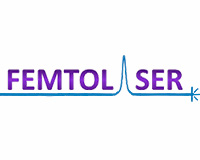The objective of the project is the development and manufacture in Spain of a femtosecond laser system, low average power (1 W), small size (portable) and affordable (low cost) for industrial use. (http://www.femtolaserproject.com)
Femtosecond lasers have a considerable advantage: they are the most accurate among the existing lasers for micromachining of materials. Their special features are the generation of ultrashort optical pulses in the femtosecond range (1 fs = 10-15 s, i.e. a millionth of billionth of second). A technique, now well known, for short pulses generation is the "Q-switching" but it is not suitable for ultrashort pulses generation (it generates laser pulse with duration > 1 ns at a low repetition rate, that is 1-200 kHz). Therefore, ultrashort pulses are typically generated with the technique "passive mode-locking" (that is with a passive blocking of the laser modes which is a technique that allows putting in phase the longitudinal modes of the laser cavity supporting by the bandwidth of the fluorescent ion) but sometimes also with optical parametric amplifiers or with free electron lasers. This technique ("passive mode-locking") enables to generate laser pulses from picosecond to femtosecond duration at a quite high repetition rate (> 10 MHz). It is also possible to start with longer pulses and apply a pulse compression method (CPA method for Chirped Pulse Amplification).
Thanks to this property the pulses reach extreme intensities or peak powers. Some femtosecond lasers give peak power that exceed TW (> 1012 W), that is as much as the installed power on the planet said Prof. Gerard Mourou, one of the creators of the CPA method for femtosecond lasers. But power does not mean energy. At the maximum of the pulse, it is true that the energy applied per unit of time is very high but as the pulse lasts few femtoseconds, the energy carried is small: from nanojoule to few joule maximum. The consequence is that femtosecond lasers operate a radical and fast destruction of the matter but limited where the intensity is greater, that is at the laser focus point and during the short time interval of pulse duration. Each pulse interacts only with a surface of few square micrometers and along a depth of 40 nm at moderated powers. The result obtained is that released from their intra-molecular bonds and ionized by the intense electric field associated with the laser beam, the atoms are removed and ejected. This phenomenon is so fast and concerns a volume so small that the heat does not have time to diffuse into the treated material (or the thermal diffusion is negligible). That's why the area to process can be defined with a quasi absolute accuracy. On the other hand, other lasers processes are associated with a strong thermal diffusion making difficult to define precisely the area and presents the drawback to melt or transform the matter. This difference can be seen in the following figure. Another advantage of these lasers is that they can go through a certain thickness of material acting in the volume without surface and crossed path damages, given that femtosecond lasers have effect only at the focus.
Thus, the combination of a high pulse power, a low ablation threshold associated and a small area affected by thermal diffusion makes the femtosecond laser a very interesting tool for marking and micro-machining.
However, some limitations come into the picture particularly when using very short pulses, under a few cycles of optical wave per pulse. For example, the broad spectral bandwidth of these pulses leads to problems of chromatic dispersion in optical components (lens, glass, fiber, etc.) leading to chromatic aberrations of the focalization optics and significant dispersive effects, unless special techniques are used for correction. This can lead to complex spatio-temporal effects, which may cause the focused pulse lasts longer than the pulse before focusing. Possible precautions against these distortions include the use of reflective or diffractive optics (rather than refractive) and compensation of various types of aberrations, for example using suitable combinations of special lenses and optical fibers.
Objectives
Main objective
To Develop and manufacture in Spain a femtosecond laser system, low average power (1 W), small size (portable) and affordable (low cost) for industrial use.
Technical objectives of the project
- To develop 2 new laser system prototypes, compact, pre-marketable and able to produce pulses in the femtosecond range:
- One based on fiber optics resonator
- One based on solid state resonator
- To decrease the size of the current laser systems and, at the same time, to reduce the building cost and maintenance thanks to the development of a new femtosecond laser system.
- To draw up a series of applications for the femtosecond laser system and establish the ones that have a higher potential for marketing.
- To maintain the physical and chemical stability of the photo-irradiated materials.
-
To provide Easy Laser with the technology of femtosecond laser developing together with the involved public research centers the first femtosecond laser fully produced in Spain.
Unión Europea: Fondo Europeo de desarrollo Regional ; Ministerio de Economía y Competitividad
Easy Laser ; CSIC (Consejo Superior de Investigaciones Científicas) ; Universitat de València ; CLPU (Center for Ultrashort Ultraintense Pulsed Lasers)











